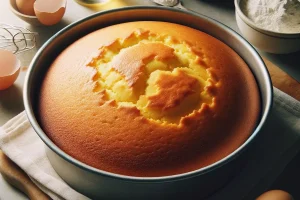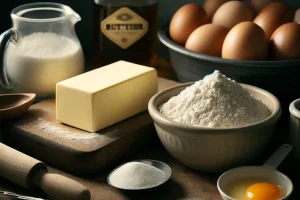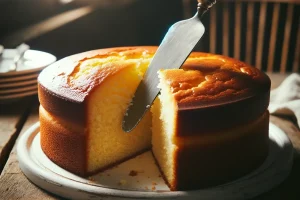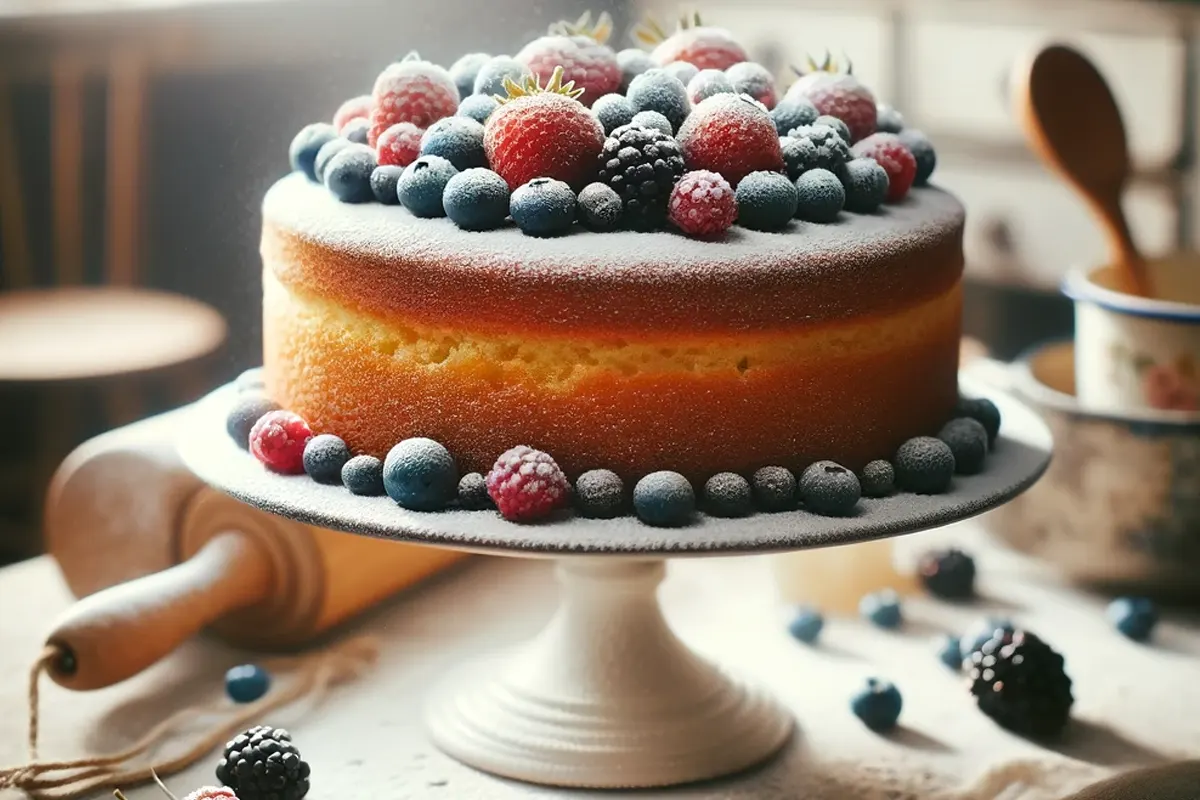Welcome to the delightful realm of butter cake, a classic favorite that has tantalized taste buds across generations and cultures. This article embarks on a comprehensive journey through the essence of butter cake – from its rich history and key ingredients to the art of baking the perfect cake. We’ll explore various recipes, including the cherished classic version and intriguing global variations, alongside essential baking tips to ensure your cake is the talk of the table. So, whether you’re a seasoned baker or a curious newbie, this guide promises to enhance your baking repertoire and deepen your appreciation for the humble butter cake.
Introduction to Butter Cake
A Slice of History
Butter cake, as its name suggests, is a cake where butter is a key ingredient, contributing to its distinctive flavor and texture. For health-conscious individuals, understanding the impact of such ingredients is crucial, as highlighted by the World Health Organization’s guidelines on healthy diets. Its roots, similar to the delights explored in our Butter Pecan Pound Cake article, can be traced back to the European butter-based cakes, evolving significantly over the centuries. This cake stands as a testament to the simplicity and elegance of traditional baking, where quality ingredients speak volumes, and the joy of baking is celebrated in every bite.
The Popularity of Butter Cake
The enduring popularity of butter cake lies in its simplicity and the comforting, rich taste that butter imparts. Unlike more elaborate cakes, a butter cake doesn’t rely on extravagance but shines through its moist, tender crumb and buttery goodness. It’s a versatile canvas for bakers, serving as a base for various flavors and decorations, making it a beloved choice for everything from afternoon teas to grand celebrations.
One might wonder, What is the difference between a butter cake and a pound cake? While both cakes boast a rich, buttery flavor, the main distinction lies in the recipe’s ratios. Traditionally, pound cake called for a pound each of butter, sugar, eggs, and flour, giving it a denser texture. Butter cake, on the other hand, often incorporates milk and leavening agents like baking powder, resulting in a lighter, softer crumb.
Whether enjoyed in its purest form or dressed up with frosting and fruits, butter cake remains a cherished favorite, a symbol of home, warmth, and the simple pleasures of life. As we delve deeper into the nuances of baking the perfect butter cake, remember that the journey is as delightful as the destination. So, preheat your ovens, and let’s embark on this buttery adventure together.
In the next section, we’ll whisk into the basics of butter cake, exploring the essential ingredients and equipment needed to bake this classic delight. Stay tuned as we lay the foundation for creating your masterpiece.

The Basics of Butter Cake
Ingredients Overview
At the heart of every delectable butter cake lies a symphony of simple yet essential ingredients, each playing a pivotal role in crafting the cake’s signature texture and flavor. The cornerstone, of course, is butter, whose quality cannot be overstated; it imbues the cake with its characteristic richness and tender crumb. High-quality, unsalted butter is preferred, allowing you to control the cake’s saltiness to perfection.
Flour forms the cake’s structure; typically, all-purpose flour does the trick, lending a balanced texture. For those looking for alternatives, explore our Gluten-Free Cupcakes guide. However, for an even finer crumb, some bakers opt for cake flour with its lower protein content. Eggs, the binding agents, contribute to the cake’s stability and richness, with each egg weaving its magic into the batter.
Sugar doesn’t just sweeten the deal but also aerates the butter during creaming, adding volume and lightness. And then, the unsung heroes: baking powder and milk. Baking powder, a leavening agent, breathes life into the cake, ensuring it rises to fluffy heights. Milk moistens and softens the batter, enhancing the cake’s tender texture. Together, these ingredients harmonize to create the classic butter cake we adore.
Essential Equipment
The right tools can transform baking from a daunting task to a delightful experience. Moreover, for butter cake, the essentials begin with the right mixing bowls. Preferably, have a set of varying sizes for different stages of mixing. Additionally, a sturdy electric mixer, stand or handheld, saves you from a workout, creaming butter and sugar to light and fluffy perfection.
Measuring cups and spoons are your best friends, ensuring precision in baking, where accuracy is non-negotiable. Then comes the cake pan – typically, a round or square 8-inch pan suits most butter cake recipes. But remember, the pan’s material can affect the baking time and cake’s texture; aluminum pans are widely favored for their even heat distribution.
Don’t forget the parchment paper, a baker’s ally in ensuring your cake releases flawlessly from the pan. A cooling rack is the final touch, allowing your cake to cool properly, preventing soggy bottoms, and ensuring the perfect finish to your buttery masterpiece.
Equipped with the right ingredients and tools, you’re set to embark on the butter cake baking journey. As we progress, keep in mind the pivotal role each element plays, from the quality of butter to the choice of pan, all weaving together to create a cake that’s more than just a treat—it’s an experience. Up next, we’ll dive into the classic butter cake recipe and its delightful variations, guiding you through each step to achieve that perfect bake. Stay tuned, and happy baking!
Butter Cake Recipes
Classic Butter Cake Recipe
Embarking on the journey of baking a classic butter cake, or even bite-sized versions as featured in our Mini Cupcakes guide, is like paying homage to the timeless art of simple, yet profoundly delightful desserts. Additionally, the essence of this recipe lies in its simplicity, allowing the butter’s rich flavor to shine through, complemented by the tender crumb and delicate sweetness.
Ingredients:
- 1 cup (2 sticks) unsalted butter, softened
- 1 ½ cups granulated sugar
- 4 large eggs, at room temperature
- 2 ¾ cups all-purpose flour
- 1 tablespoon baking powder
- ½ teaspoon salt
- 1 cup whole milk
- 2 teaspoons pure vanilla extract
Instructions:
- Preheat your oven to 350°F (175°C). Grease and flour an 8-inch cake pan, lining the bottom with parchment paper for easy removal.
- In a large mixing bowl, cream the softened butter and sugar together with an electric mixer until light and fluffy, about 3-4 minutes. This process introduces air into the batter, a crucial step for a soft cake.
- Beat in the eggs, one at a time, ensuring each is fully incorporated before adding the next. This builds the cake’s structure.
- In a separate bowl, whisk together the flour, baking powder, and salt. Gradually add the dry ingredients to the butter mixture, alternating with the milk, starting and ending with the flour mixture. This method prevents overmixing, preserving the cake’s tender crumb.
- Stir in the vanilla extract, blending just until the batter is smooth and well-combined.
- Pour the batter into the prepared pan, smoothing the top with a spatula. Bake for 35-40 minutes, or until a toothpick inserted into the center comes out clean.
- Let the cake cool in the pan for 10 minutes, then transfer to a wire rack to cool completely. This patience ensures your cake retains its perfect texture.

Variations of Butter Cake
While the classic butter cake is a marvel in its own right, the recipe’s versatility invites a plethora of variations, each adding a unique twist to the original.
Lemon Butter Cake: Add the zest of one lemon to the batter, infusing the cake with a bright citrus aroma. A simple lemon glaze made from powdered sugar and lemon juice drizzled over the cooled cake elevates it to a refreshing dessert, ideal for spring gatherings.
Chocolate Chip Butter Cake: Fold in 1 cup of mini chocolate chips into the batter for a delightful twist that chocolate lovers will adore. The chips melt slightly, creating pockets of chocolatey goodness throughout the cake.
Spiced Butter Cake: For a warm, comforting variant, incorporate a teaspoon of ground cinnamon, a half teaspoon of ground nutmeg, and a quarter teaspoon of ground cloves into the dry ingredients. This spiced butter cake pairs beautifully with a cup of tea on a cozy autumn afternoon.
These variations demonstrate the adaptability of the butter cake, capable of transforming to suit any palate or occasion. Whether you stick to the timeless classic or venture into flavorful renditions, the journey of baking butter cake is filled with sweet rewards.
In the next segment, we’ll dive into baking techniques and tips, ensuring your butter cake not only tastes divine but also boasts the perfect texture and appearance. Stay tuned for the insider secrets to elevating your butter cake to bakery-level perfection.
Baking Techniques and Tips
Mastering the art of baking the perfect butter cake requires more than just following a recipe. It’s about embracing the nuances that transform a good cake into a great one. Here, we delve into the alchemy of baking, offering tips and techniques that ensure your cake is lauded for its moist, tender texture and flawless flavor.
Baking Tips for the Perfect Texture
- Room Temperature Ingredients: It’s crucial to start with room temperature butter, eggs, and milk, as emphasized in our Gluten-Free Sugar Cookies guide. This ensures a smoother batter, leading to a uniformly textured cake. Cold ingredients can lead to a curdled batter, affecting the final cake’s texture.
- The Creaming Method: The act of creaming butter and sugar isn’t just a step; it’s where the magic begins. Aim for a pale and fluffy mixture, as this process incorporates air into the batter, promising a lighter cake. A good 3-5 minutes with an electric mixer should do the trick.
- Sift, Then Measure: Sifting flour and leavening agents not only removes lumps but also aerates the mixture, contributing to a finer cake crumb. Remember, always sift first, then measure to avoid using too much flour, which could result in a dense cake.
- Gentle Folding: When combining the dry and wet ingredients, a gentle hand is key. Overmixing can activate gluten in the flour, leading to a tough cake. Mix just until the ingredients are combined, and no flour streaks remain.
- Don’t Peek: Opening the oven door too early can cause a significant temperature drop, affecting the cake’s rise. Be patient and only check for doneness towards the end of the baking time.
Common Mistakes to Avoid
- Overbaking: It’s better to err on the side of slightly underbaking than overbaking. An overbaked cake is dry and crumbly. Start checking for doneness a few minutes before the recipe suggests, and remember, if the toothpick comes out with a few moist crumbs, the cake is done.
- Improper Pan Preparation: Grease and flour your pan thoroughly, or use parchment paper to prevent sticking. This simple step can mean the difference between a cake that releases beautifully and one that stubbornly sticks to the pan.
- Ignoring Oven Quirks: Every oven is unique, with its own temperament and hot spots. Get to know your oven’s personality, possibly using an oven thermometer to ensure accurate temperature settings. Adjust the cake’s position if necessary to avoid uneven baking.
- Skipping the Cooling Process: Allow the cake to cool in the pan on a wire rack for about 10 minutes before turning it out. Rushing this process can lead to a cracked or broken cake. Cooling completely before frosting is equally vital to prevent a melted mess.
With these tips and tricks up your sleeve, you’re well on your way to baking a butter cake that boasts not only a divine taste but also a professional look and texture. Remember, baking is as much science as it is art, and sometimes, the smallest adjustments lead to the most triumphant results.
As we continue our baking journey, we’ll next explore the world of butter cake variations in different cultures, showcasing how this beloved dessert adapts and thrives across global culinary landscapes. Furthermore, stay tuned for a delectable exploration of butter cakes from around the world.
Butter Cake in Different Cultures
Butter cake, with its rich, tender crumb and buttery goodness, serves as a beloved canvas for a myriad of cultural interpretations and culinary traditions. As we journey through the world of butter cake, we uncover the delightful diversity that this simple cake embraces, adapting to local flavors and baking traditions. This exploration not only broadens our baking horizons but also unites us through the universal language of cake.
American Southern Butter Cake
In the heart of the American South, the butter cake takes on a decadently moist and dense form, often referred to as “Kentucky Butter Cake.” This variant is beloved for its rich butter sauce, infused with vanilla and a touch of sugar, which is poured over the cake while it’s still warm, creating a moist interior and a slightly crisp exterior. It’s a testament to Southern hospitality, offering a warm, buttery welcome to all who taste it.
British Victoria Sponge
Crossing the Atlantic, the British interpretation of butter cake manifests as the elegant Victoria Sponge Cake, named after Queen Victoria. This light and airy cake, sandwiched with a layer of jam (traditionally strawberry) and dusted with powdered sugar, epitomizes afternoon tea. Some variations also include a layer of whipped cream, adding a luxurious richness that contrasts beautifully with the light sponge layers.
Malaysian Pandan Butter Cake
Venturing further east, Malaysia offers a tropical twist on the classic butter cake with the Pandan Butter Cake. Infused with the juice of pandan leaves, this cake boasts a vibrant green hue and a unique, fragrant flavor that’s often described as a blend of vanilla and coconut. It’s a staple in Malaysian households, especially during festive seasons, symbolizing prosperity and good fortune.
German Butterkuchen
In Germany, the Butterkuchen, or “butter cake”, takes a form reminiscent of a yeasted sheet cake, generously dotted with butter and sprinkled with sugar and almonds. Often enjoyed with afternoon coffee, this version is particularly popular in northern regions and is a fixture at local festivals and gatherings, showcasing the communal spirit of German baking traditions.

French Quatre-Quarts
The French contribution to the butter cake family is the Quatre-Quarts, translating to “four quarters”, which mirrors the simplicity of the traditional pound cake, with equal parts (by weight) of flour, butter, eggs, and sugar. This cake is often enhanced with lemon or orange zest, adding a subtle but bright flavor that elevates the simple elegance of the French culinary ethos.
Each of these variations of butter cake not only showcases the versatility of this beloved dessert but also tells a story of cultural heritage and culinary innovation. From the dense, moist crumb of the Southern butter cake to the fragrant allure of the pandan-infused Malaysian version, butter cake continues to be a canvas for expression across cultures, bringing people together in the universal act of baking and sharing.
As we continue to explore the rich tapestry of butter cake variations around the globe, we’re reminded of the power of simple ingredients to create connections, evoke memories, and celebrate the diverse tapestry of culinary traditions that enrich our world. Moreover, join us in the next section as we delve into advanced butter cake topics, including creative decorating and frosting techniques that will inspire your next baking adventure.
Advanced Butter Cake Topics
Embarking on advanced topics in the realm of butter cake opens a door to endless creative possibilities. Moreover, beyond the basic recipe lies a world of intricate decorating techniques and thoughtful flavor pairings that can elevate your butter cake from a simple dessert to an extraordinary centerpiece. Additionally, this segment is dedicated to all baking enthusiasts eager to explore the artistry that turns a classic butter cake into a masterpiece of taste and visual appeal.
Decorating and Frosting Techniques
Layering and Filling: Transform your butter cake into an elegant layered masterpiece by slicing the cake horizontally and spreading each layer with your choice of filling. Classic options include raspberry jam, lemon curd, or a rich chocolate ganache. This not only adds depth of flavor but also introduces an element of surprise with each bite.
Buttercream Mastery: Learning to make a smooth, creamy buttercream is essential for any cake decorator. For a twist, incorporate flavors like salted caramel, espresso, or citrus zest into your buttercream for a delightful contrast to the buttery cake. Mastering various piping techniques can add texture and elegance, from simple rosettes to intricate lace patterns.
Fondant Accents: While a full fondant cover might be too heavy for a butter cake, using fondant accents can add a touch of sophistication. Consider delicate flowers, leaves, or even custom shapes that reflect the theme of your celebration. Fondant requires patience and practice, but the results can be stunning.
Edible Decor: From fresh berries to edible flowers and gold leaf, natural decor can give your butter cake an organic, chic look. Not only do these elements enhance the beauty of your cake, but they also add a fresh burst of flavor.
Pairing Butter Cake with Beverages
The perfect pairing can enhance the butter cake experience, making it a memorable part of any meal or gathering.
Tea Pairings: A light, fragrant tea like Earl Grey or Jasmine complements the richness of butter cake without overpowering it. The floral notes of the tea can elevate the subtle flavors of the cake, creating a harmonious balance.
Coffee Combinations: A robust coffee or a well-made cappuccino can be the ideal counterpart to a slice of butter cake. The bitterness of the coffee contrasts beautifully with the sweetness of the cake, making for a satisfying combination.
Milk & Infusions: For a comforting, nostalgic pairing, nothing beats a glass of warm milk with butter cake. To add a twist, consider infusing the milk with vanilla, cinnamon, or even lavender for a subtly flavored accompaniment that enhances the cake.
Exploring advanced topics in butter cake baking and decorating not only broadens your culinary skills but also opens up new avenues for creativity and personal expression. Whether it’s crafting the perfect buttercream swirl, experimenting with fondant, or discovering the ideal beverage pairing, the world of butter cake offers endless opportunities to delight and surprise.
As we wrap up this comprehensive guide to butter cake, we hope you’re inspired to embark on your own baking adventures, armed with the knowledge, techniques, and creativity to bring your butter cake dreams to life. Furthermore, stay tuned for the final segment, where we’ll tackle some of the most frequently asked questions about butter cake, ensuring you’re well-equipped to face any baking challenge that comes your way.
FAQs
In our butter cake odyssey, we’ve kneaded through history, whipped through recipes, and piped our way through decorating techniques. Now, it’s time to sift through some of the most frequently asked questions about butter cake. These inquiries often arise in the minds of bakers, both novice and experienced, as they embark on their baking adventures. Let’s demystify these queries, ensuring your next butter cake is not just good, but exceptional.
Why did my butter cake turn out dry?
A dry butter cake can result from a few culprits: overbaking is a common one, as even a few extra minutes in the oven can sap moisture from your cake. Ensure you’re measuring ingredients accurately, especially flour, as too much can absorb moisture needed for a tender crumb. Also, don’t skimp on the butter – it’s not just for flavor but adds necessary fat to keep the cake moist.
Can I substitute margarine for butter in a butter cake?
While margarine can be used in a pinch, it won’t yield the same rich flavor and texture that butter imparts. Butter’s unique composition contributes to the cake’s moisture, rise, and tender crumb. If you must substitute, opt for a high-quality margarine with a high fat content, but be prepared for a slight difference in the final product.
How can I ensure my butter cake rises properly?
Proper rising hinges on a few factors. First, ensure your baking powder is fresh, as it loses potency over time. The creaming process is also crucial – adequately creamed butter and sugar trap air, which expands in the oven, aiding the rise. Lastly, avoid opening the oven door while baking, as temperature fluctuations can cause the cake to fall.
What’s the best way to store butter cake?
To maintain freshness, store butter cake in an airtight container at room temperature for up to three days. If frosted, and the frosting is perishable, store it in the refrigerator, but let it come to room temperature before serving to ensure the best flavor and texture. For longer storage, wrap the unfrosted cake tightly in plastic and freeze for up to three months.
How can I add flavor to my butter cake without compromising its texture?
Infusing your cake with flavor doesn’t have to mean altering its tender crumb. Firstly, you can add citrus zest, extracts, or spices to the batter for a subtle flavor boost. Alternatively, for a more pronounced taste, incorporate flavored syrups or liqueurs (non-alcoholic options are available) into the cake after baking. By gently brushing them over the top and allowing the liquid to soak in, you can impart a rich flavor without compromising the cake’s texture.
By addressing these common inquiries, we aim to smooth the path to your perfect butter cake, one where challenges are mere stepping stones to delectable success. Remember, each baking journey is unique, filled with trials, triumphs, and, most importantly, slices of joy. So, preheat your oven, butter your pans, and let the sweet aroma of baking fill your kitchen and heart. Happy baking!

